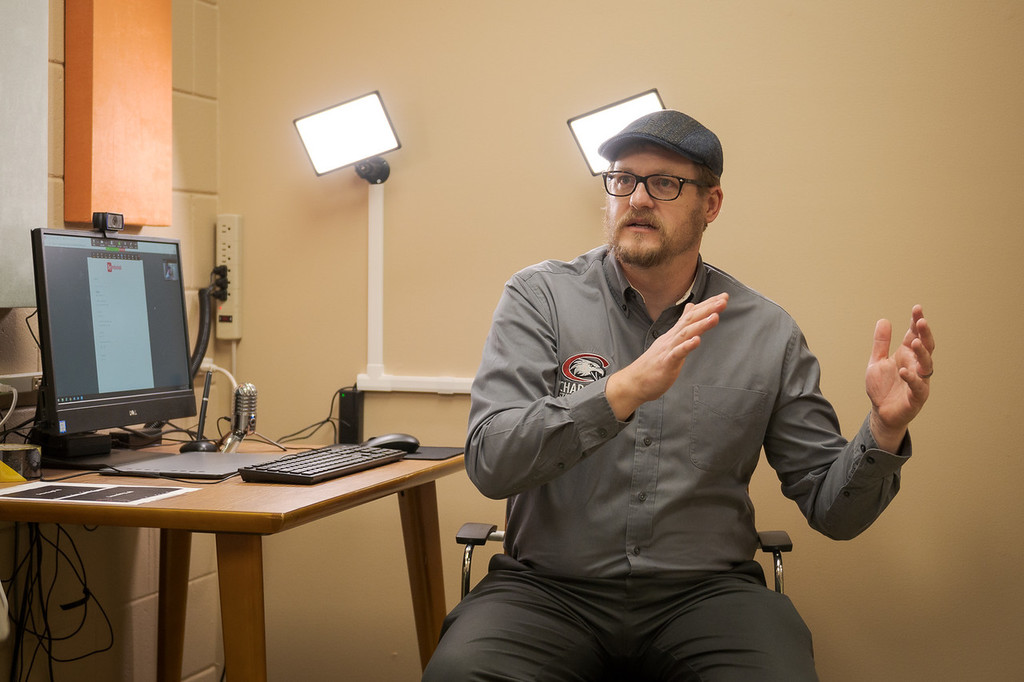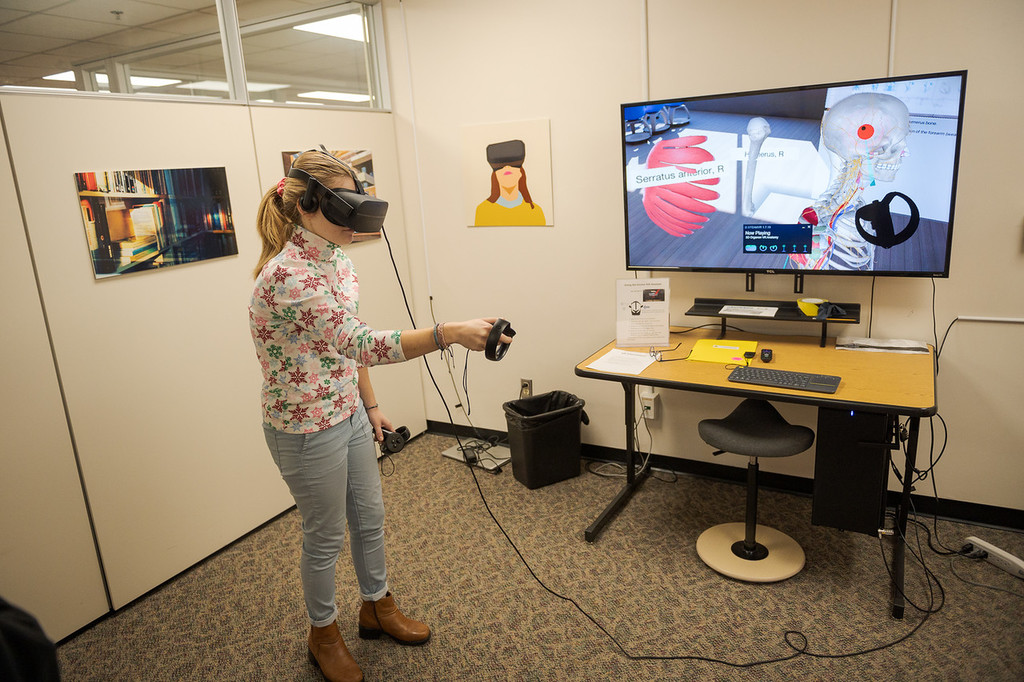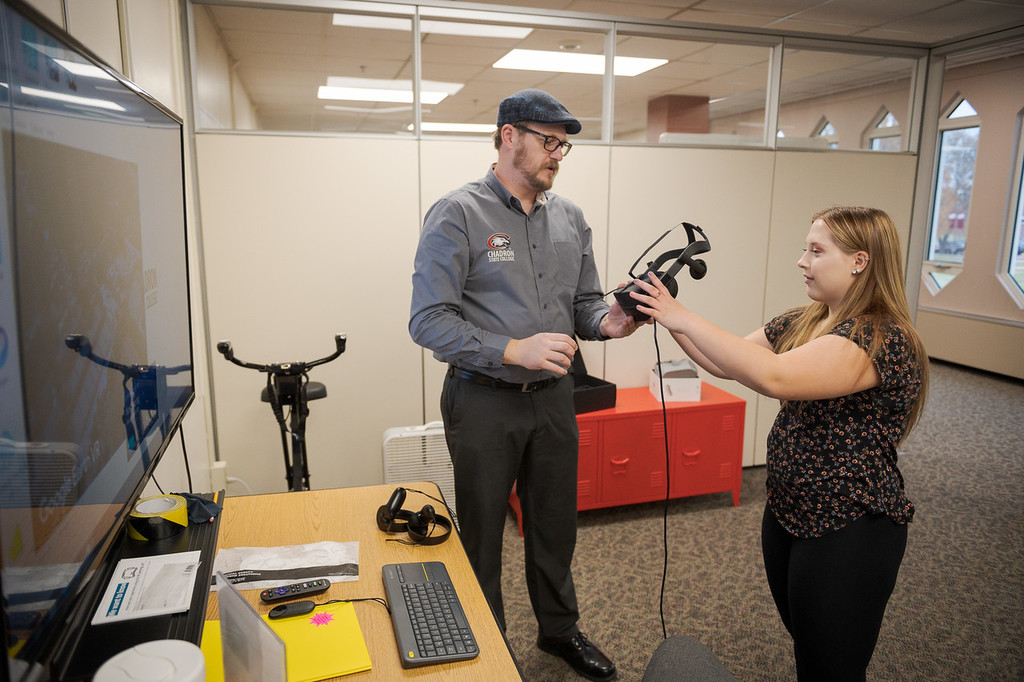Virtual Reality offers education benefits, recreation opportunities for CSC students

CHADRON – Virtual Reality (VR), the technology that allows a person to figuratively step into and explore a computer created three-dimensional world that can feel completely real, has made its debut in the King Library Learning Commons at Chadron State College.
CSC’s first venture into VR has both educational and recreational value for students, and is one of several efforts underway at the library’s tutoring center to provide innovative educational opportunities for students, said Tom Tylee, Director of the Office of Academic Success.
The suite of technology applications available at the tutoring center and the Richards Media Lab includes digital systems for producing music and graphic design work, an internet-connected, touchscreen smart board for group work, and a small studio that can be used for live video interactions with online students or to create instructional videos for classes.
Among the new technologies, VR seems to be the most popular so far, according to Tylee.
“I think everybody who has come in and tried it is pretty wowed by the experience, because it’s so immersive,” he said.
The VR experience begins with donning a headset that projects images in front of the user’s eyes and sounds into the ears. The images change as the user moves in the environment created by the program. A pair of gloves allow manipulation of virtual objects the user encounters. A large screen on the wall of the VR room lets others view in two dimensions what the user is seeing in 3D.
CSC sophomore education major Mackenzie Helm tried the VR set for the first time recently as part of an assignment for a technology in learning class. Helm first tested a program that transported her to Devil’s Tower and Mammoth Hot Springs in Wyoming, places she has visited in person.
“It was really cool. I got to go to places I knew and see them in a prettier time than winter,” she said.
With VR, Helm experienced the view from the top of the iconic rock formation.
“I felt like I was standing on it,” she said.
Using a program designed for anatomy instruction, Helm then viewed a human body from different angles, and tried separating individual parts for closer inspection. Another program took her onto a wooden plank extending directly out from the top of a skyscraper, a dizzying experience that ended when she fell to the pavement below. She also tried a less fear-inducing program that made her a superhero firefighter flying around a city extinguishing blazes.
The college has both educational and entertainment VR programs, said Tylee. One history-related program takes the user along on a WWII bombing raid over Germany, using film recorded by a BBC reporter during an actual raid, he said.
Another program lets the user tour the Anne Frank house while hearing excerpts from her famous diary. The library’s collection includes many applications for history and art, especially visits to art museums, Tylee said.
Some CSC instructors have already taken advantage of VR’s capabilities for immersive instruction, according to Tylee. A physiology class had students tour a haunted house and measured vital signs to study stress response, he said, and a class on gender studies used a science fiction program to give students the experience of being an African-American woman.
Helm said she could see VR’s potential in her future teaching career.
“There’s a lot of benefit, like getting to go places (students) may not be able to go,” she said. “It’s like you get to go across the world.”
The tutoring center’s group study workstation has more distinctly educational applications, with an interactive format that makes it a good resource for instructors and tutors, according to Tylee. An anatomy program, for example, gives a detailed view of a human cadaver that groups of students can study together.
“You can rotate around (the image) and select different parts of the body. It gives you information about it, some of the diseases that would affect it, and how to pronounce (the scientific name),” Tylee said.
The workstation’s interactive capabilities, which allow both parties to write on the whiteboard screen, are particularly useful for tutors working with online students, Tylee noted.
In setting up the small video production studio in the library, Tylee said his primary aim was to improve the online tutoring experience. A high quality microphone, sound dampening panels in the room, good lighting, and a green screen that creates a neutral background for the instructor serve to reduce distractions during the live-streamed learning sessions conducted via the Zoom teleconferencing application, he said.
“We want the technology to just disappear. We want the exact same experience (for online students) as though you are sitting face-to-face across from another person,” Tylee said.
The studio can also function as a quiet testing room, for creating instructional videos, or by students for online job interviews, said Tylee.
Rapid developments in technology, many spurred by the popularity of online gaming, can make it difficult to keep up with the latest equipment, Tylee acknowledged.
“It’s being able to find that balance of usability, keeping up with the technology, but not spending thousands of dollars,” he said.
The aim isn’t just to have the latest equipment, though, and Tylee said he wants to develop flexible spaces in the library that have multiple uses, contribute to educational goals and aren’t just focused on electronic devices.
“It’s nice when you are not just doing it for the sake of using technology; that the technology is contributing something that you would otherwise not be able to do,” he said. “That’s why I love VR. You can fly around with a jet pack, jump off a plank and be just fine, or be scared out of your wits in a haunted house and still be in the library.”
Category: Campus Announcements, Campus News, Student Services


